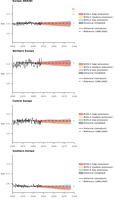
Mean wind speed is a base index accounting for the average values of wind speed at 10 m height over longer timescales (e.g., seasonal or annual).

The index reports the total number of days per year with a critical level of fire danger. Fire danger is based on the Canadian Fire Weather Index (FWI) which is one of the most commonly used fire indices globally. It is based on a numerical rating of the potential frontal fire intensity and combines the rate of fire spread with the amount of fuel being consumed. The calculation of FWI requires several meteorological input variables (see the ETC-CCA Technical Paper for details).
FWI values are classified into several fire danger classes. According to the classification of the European Forest Fire Information System (EFFIS; EC, 2020), FWI values in the range 11.2-21.3, 21.3-38 and 38-50 represent ‘moderate’, ‘high’ and ‘very high’ fire risk, respectively. However, different classifications are being used at national levels. The index presented here shows the annual number of days with high fire danger conditions (defined as daily FWI values above 30 in the underlying CDS dataset).

The index magnitude of meteorological droughts combines information about the duration and severity of droughts. It is defined as the positive sum of the SPI for all the months within drought events in a given year, thereby giving more weight to months with severe droughts than those with less severe droughts (see the ETC-CCA Technical Paper for details). For consistency with ‘Duration of meteorological droughts’ above, this index is also based on SPI-3 and a threshold of -1 is used to identify drought occurrences. Alternative aggregation periods for SPI can be used depending on the type of drought considered and the specific applications.

The duration of meteorological droughts represents the average number of months in a year experiencing drought conditions as determined by anomalously low precipitation values. The index is based on the Standardized Precipitation Index aggregated over three months (SPI-3), which accounts for the deficit or surplus of precipitation with respect to a reference period. Alternative aggregation periods for SPI can be used depending on the type of drought considered and the specific applications. SPI values represent standard deviations of precipitation from the long-term mean. A drought event is considered to start when SPI values fall below -1 for at least two consecutive months and to end when the index returns to a positive number (see the ETC-CCA Technical Paper for details).

The frequency of extreme precipitation refers to the total number of days in a year with total precipitation exceeding the 99th percentile of the daily precipitation values during the reference period. Other implementations of this index may use a different percentile (e.g., 95th) depending on the level of rarity of events to be considered.
Document Actions
Share with others